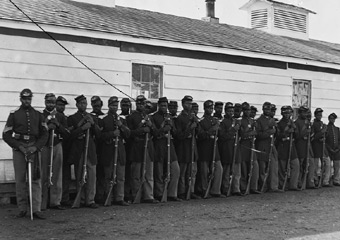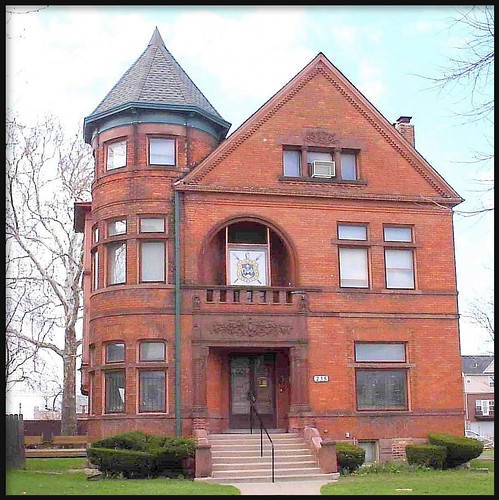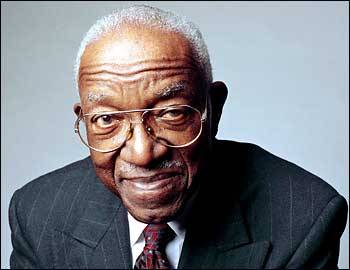If you think Lonnie Johnson’s only claim to fame would be the Super Soaker squirt gun, think again. His latest invention, the Johnson Thermoelectric Energy Converter (JTEC) is a device Johnson feels could turn solar energy into heat. His challenge with this device? Getting military scientists and engineers to not think of him as a toy inventor, take him seriously, and fund the project.
From THE ATLANTIC:
IN MARCH 2003, the independent inventor Lonnie Johnson faced a roomful of high-level military scientists at the Office of Naval Research in Arlington, Virginia. Johnson had traveled there from his home in Atlanta, seeking research funding for an advanced heat engine he calls the Johnson Thermoelectric Energy Converter, or JTEC (pronounced “jay-tek”). At the time, the JTEC was only a set of mathematical equations and the beginnings of a prototype, but Johnson had made the tantalizing claim that his device would be able to turn solar heat into electricity with twice the efficiency of a photovoltaic cell, and the Office of Naval Research wanted to hear more.
Projected onto the wall was a PowerPoint collage summing up some highlights of Johnson’s career: risk assessment he’d done for the space shuttle Atlantis; work on the nuclear power source for NASA’s Galileospacecraft; engineering help on the tests that led to the first flight of the B-2 stealth bomber; the development of an energy-dense ceramic battery; and the invention of a remarkable, game-changing weapon that had made him millions of dollars—a weapon that at least one of the men in the room, the father of two small children, recognized immediately as the Super Soaker squirt gun.
Mild-mannered and bespectacled, Johnson opened his presentation by describing the idea behind the JTEC. The device, he explained, would split hydrogen atoms into protons and electrons, and in so doing would convert heat into electricity. Most radically, it would do so without the help of any moving parts. Johnson planned to tell his audience that the JTEC could produce electricity so efficiently that it might make solar power competitive with coal, and perhaps at last fulfill the promise of renewable solar energy. But before he reached that part of his presentation, Richard Carlin, then the head of the Office of Naval Research’s mechanics and energy conversion division, rose from his chair and dismissed Johnson’s brainchild outright. The whole premise for the device relied on a concept that had proven impractical, Carlin claimed, citing a 1981 report co-written by his mentor, the highly regarded electrochemist Robert Osteryoung. Go read the Osteryoung report, Carlin said, and you will see.
End of meeting.
Concerned about what he might have missed in the literature, Johnson returned home and read the inch-thick report, concluding that it addressed an approach quite different from his own. Carlin, it seems, had rejected the concept before fully comprehending it. (When I reached Carlin by phone recently, he said he did not remember the meeting, but he is familiar with the JTEC concept and now thinks that the “principles are fine.”) Nor was Carlin alone at the time. Wherever Johnson pitched the JTEC, the reaction seemed to be the same: no engine could convert heat to electricity at such high efficiency rates without the use of moving parts.
Johnson believed otherwise. He felt that what had doomed his presentation to the Office of Naval Research—and others as well—was a collective failure of imagination. It didn’t help that he was best known as a toy inventor, nor that he was working outside the usual channels of the scientific establishment. Johnson was stuck in a Catch-22: to prove his idea would work, he needed a more robust prototype, one able to withstand the extreme heat of concentrated sunlight. But he couldn’t build such a prototype without research funding. What he needed was a new pitch. Instead of presenting the JTEC as an engine, he would frame it as a high-temperature hydrogen fuel cell, a device that produces electricity chemically rather than mechanically, by stripping hydrogen atoms of their electrons. The description was only partially apt: though both devices use similar components, fuel cells require a constant supply of hydrogen; the JTEC, by contrast, contains a fixed amount of hydrogen sealed in a chamber, and needs only heat to operate. Still, in the fuel-cell context, the device’s lack of moving parts would no longer be a conceptual stumbling block.
Indeed, Johnson had begun trying out this new pitch two months before his naval presentation, in a written proposal he submitted to the Air Force Research Laboratory’s peer-review panel. The reaction, when it came that May, couldn’t have been more different. “Funded just like that,” he told me, snapping his fingers, “because they understood fuel cells—the technology, the references, the literature. The others couldn’t get past this new engine concept.” The Air Force gave Johnson $100,000 for membrane research, and in August 2003 sent a program manager to Johnson’s Atlanta laboratory. “We make a presentation about the JTEC, and he says”—here Johnson, who is black, puts on a Bill-Cosby-doing-a-white-guy voice—“‘Wow, this is exciting!’” A year later, after Johnson had proved he could make a ceramic membrane capable of withstanding temperatures above 400 degrees Celsius, the Air Force gave him an additional $750,000 in funding.
The key to the JTEC is the second law of thermodynamics. Simply put, the law says that temperature differences tend to even out—for instance, when a hot mug of coffee disperses its heat into the cool air of a room. As the heat levels of the mug and the room come into balance, there is a transfer of energy.
Work can be extracted from that transfer. The most common way of doing this is with some form of heat engine. A steam engine, for example, converts heat into electricity by using steam to spin a turbine. Steam engines—powered predominantly by coal, but also by natural gas, nuclear materials, and other fuels—generate 90 percent of all U.S. electricity. But though they have been refined over the centuries, most are still clanking, hissing, exhaust-spewing machines that rely on moving parts, and so are relatively inefficient and prone to mechanical breakdown.
Johnson’s latest JTEC prototype, which looks like a desktop model for a next-generation moonshine still, features two fuel-cell-like stacks, or chambers, filled with hydrogen gas and connected by steel tubes with round pressure gauges. Where a steam engine uses the heat generated by burning coal to create steam pressure and move mechanical elements, the JTEC uses heat (from the sun, for instance) to expand hydrogen atoms in one stack. The expanding atoms, each made up of a proton and an electron, split apart, and the freed electrons travel through an external circuit as electric current, charging a battery or performing some other useful work. Meanwhile the positively charged protons, also known as ions, squeeze through a specially designed proton-exchange membrane (one of the JTEC elements borrowed from fuel cells) and combine with the electrons on the other side, reconstituting the hydrogen, which is compressed and pumped back into the hot stack. As long as heat is supplied, the cycle continues indefinitely.
“Lonnie’s using temperature differences to create pressure gradients,” says Paul Werbos, an energy expert and program director of the National Science Foundation. “Only instead of using those pressure gradients to move an axle or a wheel, he’s forcing ions through a membrane.” Werbos, who spent months vetting the JTEC and eventually awarded Johnson’s team a $75,000 research grant in 2006, describes the JTEC as “a fundamentally new way, a fundamentally well-grounded way, to convert heat to electricity.” Regarding its potential to revolutionize energy production on a global scale, he says, “It has a darn good chance of being the best thing on Earth.”
JOHNSON IS A MEMBER of what seems to be a vanishing breed: the self-invented inventor. Born the third of six children in Mobile, Alabama, in 1949, he came into the world a black male in the Deep South during the days of lawful segregation. His father, David, who died in 1984, was a World War II veteran and a civilian driver for nearby Air Force bases. According to his mother, Arline, who is 86 and still lives in Mobile (in a house remodeled with Super Soaker profits), the family was poor but happy. All eight lived in a three-bedroom, one-bathroom house near Mobile Bay, in a neighborhood then being bisected by the construction of Interstate 10.
As a boy, Johnson was quiet and curious, and early on, he developed a fascination with how things worked. “Lonnie tore up his sister’s baby doll to see what made the eyes close,” his mother recalls. As he grew older, he began making things, including rockets powered by fuel cooked up in his mother’s saucepans. At 13, he bolted a discarded lawn-mower engine onto a homemade go-cart and took it atop the I-10 construction site—only to have a bemused policeman escort him back down. It was around then that Johnson learned that “engineers were the people who did the kind of things that I wanted to do.”
It was hardly an obvious career path: then, as now, the profession was dominated by whites. (As recently as 2004, only 1.6 percent of the engineering doctorates awarded in the United States went to blacks.) In high school, a standardized test from the Junior Engineering Technical Society informed Johnson that he had little aptitude for engineering; but he persevered and, as a senior, became the first student from his all-black high school ever to enter the society’s regional engineering fair. The fair was held at the University of Alabama at Tuscaloosa, just five years after then-Governor George Wallace had tried, in 1963, to physically block two black students from enrolling there. Johnson’s entry in the competition was a creation he called Linex: a compressed-air-powered robot assembled from electromagnetic switches he’d salvaged from an old jukebox, and solenoid valves he’d fashioned out of copper tubing and rubber stoppers. The finished product wowed the judges, who awarded him first prize: $250 and a plaque. Unsurprisingly, university officials didn’t trumpet the news that a black boy had won top honors. “The only thing anybody from the university said to us during the entire competition,” Johnson remembers, “was ‘Goodbye, and y’all drive safe, now.’”
READ THE ARTICLE IN ITS ENTIRETY HERE.



















 Lewis Temple was a slave, born in the year 1800, who was responsible for changing the whaling industry in the early 19th century. He would improve the usefulness of the whaling harpoon, which came to be known as Temple’s Toggle. Although he wasn’t actually a seaman, Temple, a blacksmith, would double the amount of production in the whaling industry with his invention.
Lewis Temple was a slave, born in the year 1800, who was responsible for changing the whaling industry in the early 19th century. He would improve the usefulness of the whaling harpoon, which came to be known as Temple’s Toggle. Although he wasn’t actually a seaman, Temple, a blacksmith, would double the amount of production in the whaling industry with his invention.
 The People’s Village is donating up to $500 in scholarships, for African American High School students. For more information, please visit.
The People’s Village is donating up to $500 in scholarships, for African American High School students. For more information, please visit.







